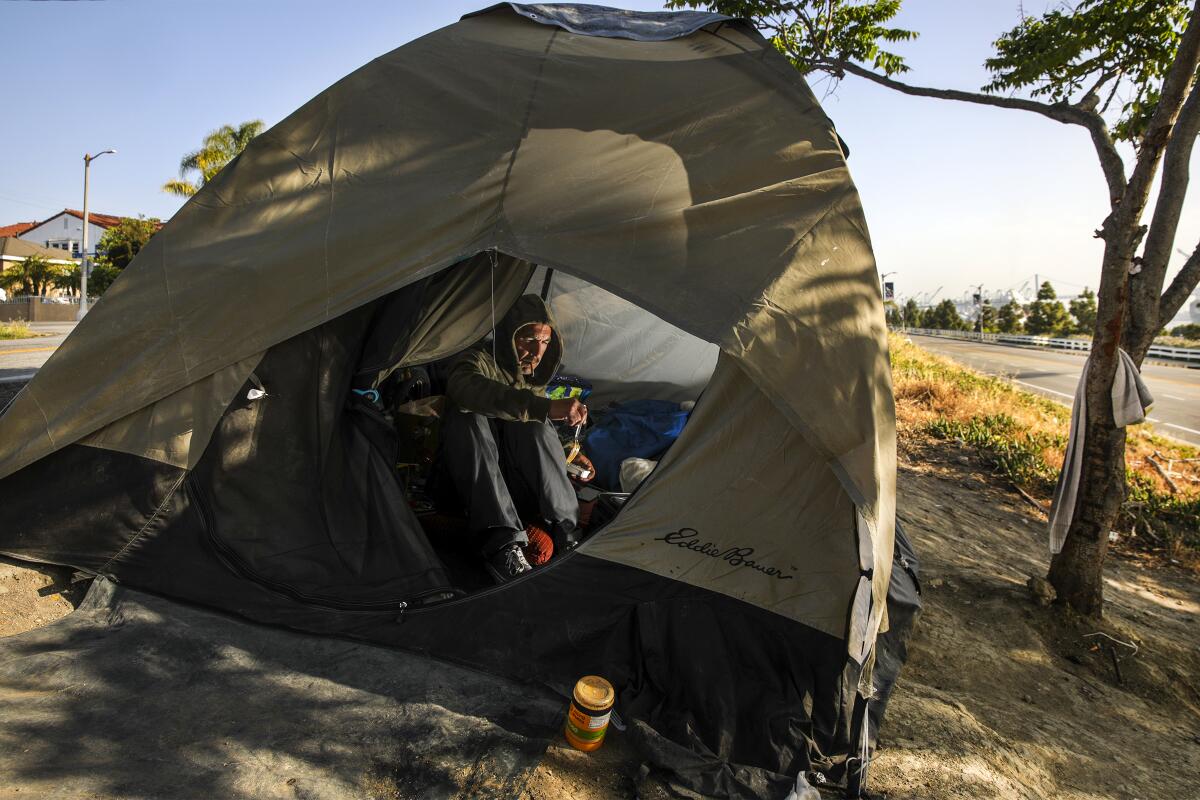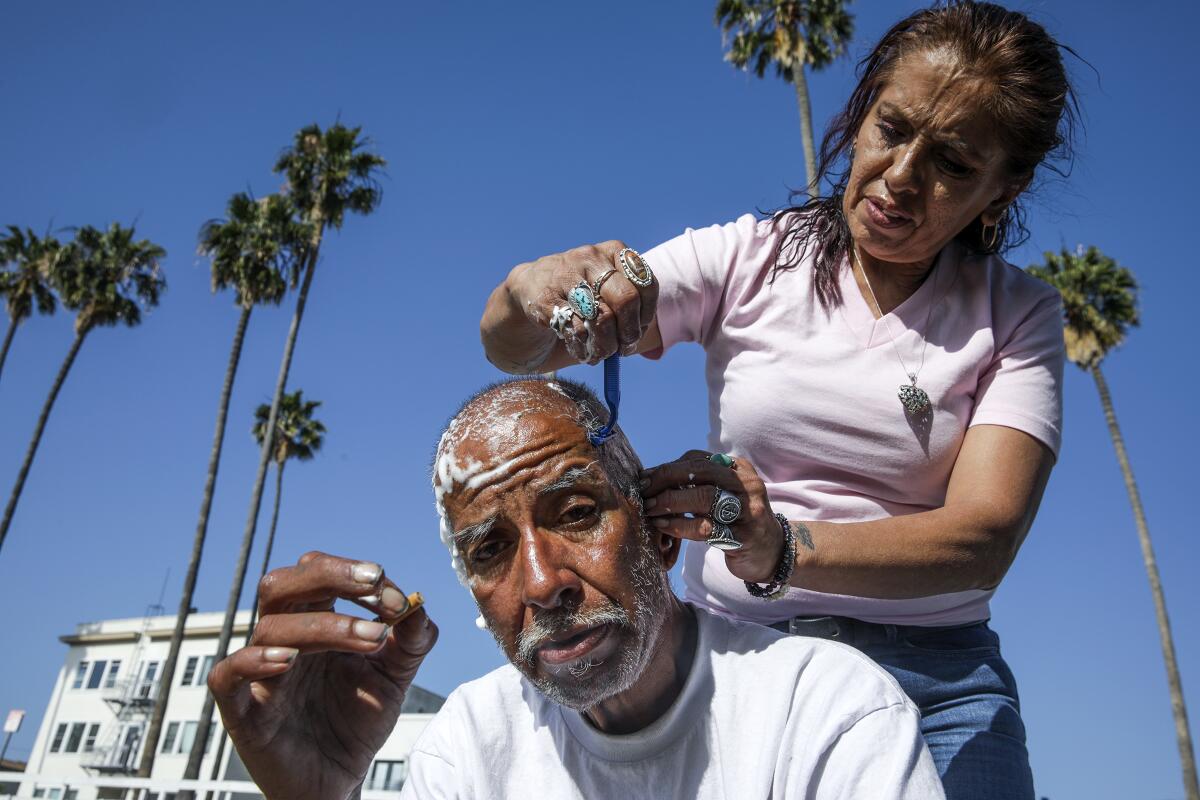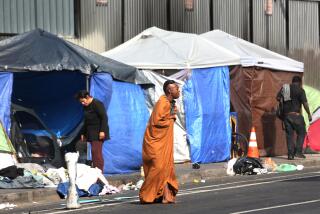The last days of a homeless encampment in San Pedro

- Share via
Jacob King holed up in his tent on the slope of a bluff overlooking the San Pedro Harbor, slumped over his knees, a cigarette wedged between scuffed fingers. It was deadline morning. City workers had posted signs saying this was the day that people in his camp had to leave.
King didn’t feel like interacting and kept to the dim light of his nylon refuge, wondering if he’d get the shelter bed he said he had signed up for a month before or be told to move again.
The 39-year-old listened to the homeless camp come to life: a tent unzipping, a laugh, distant chatter, the crisp crack of a beer can opening.
They call this strip of dirt the Gulch not because it is one but because it sits along Gulch Road, which runs up the slope between the harbor and Beacon Street on the top of the bluff.
Homeless people have long lived in this gritty southern tip of L.A., drawn to its halfway houses, dive bars and cheap motels. They can hang out in peace on the tree-shaded hillside, taking in the sea breeze and watching the bustle of the nation’s busiest port.
King grew up in San Pedro, but how he ended up on the streets seven years ago he doesn’t like to say. He gives fragments of the story: a fiancee, some type of family intervention — or as he calls it, “tough love.” He prefers to speak about his plans for after he gets housing: find a job, get his own apartment, have a stable life.
Two months earlier, he was roused from another spot and asked the police where he should go. The Gulch, they said. So King came to the camp and fell into its desultory rhythm, marked by the white noise of daytime traffic below and the moan of foghorns at night.
Now it was being targeted, part of the city of Los Angeles’ effort to get people off the streets.
In the camps, the process sometimes feels like a dismal game of musical chairs, in which for every person who gets shelter, many others return to the streets or move to the next spot, only to move again and again.
Paul Garcia, 62, sat on the curb a few tents away, sipping his beer as he got his head shaved by his best friend, Elizabeth Villalobos, 52, who had come by to check on him. She used to live here but got into long-term housing in San Pedro. Garcia says he keeps trying to get a bed, signing his name here and there when social workers show up, but nothing ever comes of it.
“Might as well put me in prison,” he said. “Just to get off the street.”
“They’ve been giving him the runaround,” Villalobos chimed in.
He mumbled something unintelligible but for a curse word.
Villalobos worries about Garcia because he suffers from high blood pressure and diabetes and sometimes has seizures. She fears he might die out here. There have been shootings in this camp, and overdoses.
With the April 30 deadline looming, people had been dropping off food and drinks. After 9 a.m., two members of a local church brought Starbucks coffee and doughnuts. One of them went to high school with King. Now, they were helping him regain copies of documents he lost when he ended up on the streets.
So much effort here goes to trying to square people’s chaotic lives into the orderly boxes needed to get them off the streets — and keep them off.

Roxanne Sanchez, 57, had returned to the camp after losing her place at a Bridge Home shelter half a mile away for failing to check in at the front desk for a third day straight.
“I was going to call, but I didn’t have a number to call them,” she said. “So I didn’t go back.”
She was packing her stuff, combing through the luggage, plastic bins and bags of clothes scattered on the dirt.
The day rolled on, and visitors stopped by to chat, drink and smoke pot. There was no sign of police or sanitation crews to clear them out. The tension subsided for a little, but the campers remained unsettled, not knowing their fate.
Maybe the city was giving them until the end of the day to move. Or until morning. Or maybe the signs had been an idle threat.
A man speaking to himself showed up, tossed a beer bottle into the street and rammed a shopping cart into the fence of a business before walking away.
The campers say they look after one another, and when benevolent strangers drop off food, they make sure everyone gets their share, not just the more aggressive or outspoken. This day, a young man with long, brown hair walked up, painfully shy and shoeless.
“Hey, you want some shoes?” one of the campers yelled out.
The young man nodded. He was handed a pair of white Adidas sneakers and two cigarettes. He thanked the group and left quietly.
::
As homeless camps popped up all over Los Angeles, the City Council last year revised its anticamping law, prohibiting people from sleeping, sitting or placing property in the public right of way. Each council member can designate no-camping zones in their districts, as long as the displaced are offered services and interim housing.
About 150 signs listing deadlines for the homeless people to leave have been posted throughout the city since the law was adopted.
Enforcement is mixed. Tents remain at many of the sites weeks or months past the deadlines. City and county officials say it’s because there aren’t enough shelters, tiny homes or hotel rooms to offer and not enough people to coordinate getting homeless people there.
Homeless advocates say the law furthers the criminalization of people living in the streets, when they deserve more services amid sparse housing options.
This year, city officials have issued only two citations for setting up tents or otherwise being in a no-encampment zone. They say the low number underscores their focus on getting people into shelters and temporary housing.
In March, the signs went up where King was living, near 7th and Beacon streets. Three weeks after he moved to the Gulch, workers installed no-camping zone signs there too.
“This is wrong. I literally have nowhere to go,” he told a reporter three days after they were posted. “I was born and raised here, I played for the high school football team, and now my own community spits on my face.”
Nearly half of the 14 people living at the encampment said they were waiting to be placed in shelters. Frustration boiled over. What were they supposed to do?
King said he’s so eager to get housing or shelter that he has chased after outreach workers as they drive by.
“I told them, ‘Hey, I want to get off the streets. I’ve been out here for years. I’m tired, man — this is just going to lead to prison or death, can you guys help me?’”
::

Reina Alvarez, 48, pitched her tent in early April on the bottom of Gulch Road, at the corner of Miner Street, a busy four-lane thoroughfare. She’d been living on the streets for four months.
“All I can do is survive now,” she said. “I ask God to get me out of this situation, because this isn’t for me.”
She was recently hit by a car and needs to go to downtown Los Angeles for physical therapy, a bus journey that takes up half her day.
The incident has her terrified that a car speeding along Miner Street is going to jump the curb and crush her while she’s sleeping. When the road is quiet, she worries that a stray bullet will hit her. She has heard of other campers whose tents have been hit with pellets or bottles. People drive by and curse at them, throwing trash.
For two months, she said, she’s been on a waiting list for a shelter. But with the deadline arriving, she felt anxious not knowing where she’d go or if the next spot would be safe.
“Ultimately, I follow the rules,” she said. “This is not my place.”
Her neighbor Carl Sanchez said he would not abide by the order to leave.
At the library, he came across a story about a lawsuit on homelessness in Boise, Idaho. In that case, the U.S. 9th Circuit Court of Appeals ruled that people experiencing homelessness cannot be criminally punished for sleeping outside on public property if there are no available alternatives.
Sanchez thought the case applied to everyone at the encampment. He wrote his summary of it, made copies and handed them out at the camp. He taped a few to the no-camping signs.
“How can people who have everything treat us like trash?” he said. “They have beds, they have air conditioning, they have cars. I don’t even have a bicycle, I don’t even have a skateboard. How dare they treat us like that?”
Ahmad Chapman, spokesman for the Los Angeles Homeless Services Authority, said that between April 11 and April 17, the agency’s teams went to the encampment six times to connect with 43 people. Outreach workers from Harbor Interfaith Services and Mental Health America went there as well.
In 2020, when the last homeless count was conducted, about 2,257 homeless people were living in San Pedro. The report found that 323 of those were sheltered and 1,934 were unsheltered.
Sanchez said many people don’t like the shelters because the tight quarters create tension, people steal, and the rules are too strict. He said he left a shelter in Long Beach when he was told he could not bring a soda inside.
His outrage faded late Saturday afternoon, when the cleanup crews and cops didn’t come. Talk turned to other subjects or drifted off. Maybe they’d actually get a reprieve.
::
Sunday morning felt like a repeat of the day before. There were no sanitation crews, no police cars — just kind people stopping by to offer coffee and doughnuts, lunch plates and water.
A live band started playing music for a 5K event.
By now, everyone felt confused. Some were convinced that they would be kicked out Tuesday, the day the city regularly cleans the area, even though county officials said the local shelters were full.
Sure enough, that Tuesday morning, everyone who was at the camp woke to see sanitation trucks and homeless agency workers on Gulch Road, backed up by eight police cruisers.
King was nowhere to be seen. The campers said he got an offer to camp in a relative’s backyard from the high school friend who had been helping him. His tent, however, remained at the Gulch.
The social workers had people sign up on waiting lists for shelter that many had already signed up for.
Not far away, the local city councilman, Joe Buscaino, who was running for mayor at the time, watched as sanitation crews started to load trash into the trucks. Buscaino became agitated when a Times reporter told him that some people were waiting to get into a shelter, but shelters were full.
“Who says they’re full?”
The county’s homeless authority, the reporter told him. Chapman, its spokesman, had said the afternoon before that the shelter sites in the San Pedro area were 97% full.
Buscaino shook his head.
“That’s b.s. — we have available beds, and I personally offered available beds just down the street. That’s why LAHSA’s got to go,” he said, referring to the Los Angeles Homeless Services Authority.
A homeless activist from the Los Angeles Community Action Network also told Buscaino that shelters had no openings. He and his staff disagreed.
Buscaino crossed the street and introduced himself to the homeless people sitting or standing next to their property. He told them there were beds available at the Bridge Home shelter.
“It’s a lot safer to be there,” he said. “Resources, showers, food.... We need you to make that choice. Please go into safer locations.”
Roxanne Sanchez stood next to her luggage, listening to Buscaino.
When she took his shelter offer, he clapped his hands and asked to hug her. She gave him a polite hug.
Reina Alvarez, who had been waiting two months for a bed, also took Buscaino’s offer, as did two others.
The Bridge Home shelter took three of them in. One person got a tiny home.
It’s unclear how space had suddenly become available. Buscaino’s office said people got into shelters because L.A. County’s Department of Public Health had allowed shelters to increase their bed count days before. But LAHSA said the restrictions, placed during the COVID-19 pandemic, were still in effect when crews cleared out the Gulch.
Three people refused to leave the area: Carl Sanchez and two activists. Police arrested them. The other campers grabbed what they could and walked off.
Sanchez was released that day, and three days passed before he could retrieve his property, including medicine. He’s back to living near the Gulch. So is Garcia.
Days later, Alvarez and Roxanne Sanchez said they’re at the Bridge Home.
“Still here, doing all right,” Sanchez said recently.
As of last week, the Gulch was still empty.
More to Read
Sign up for Essential California
The most important California stories and recommendations in your inbox every morning.
You may occasionally receive promotional content from the Los Angeles Times.









